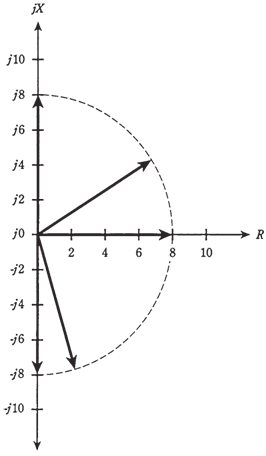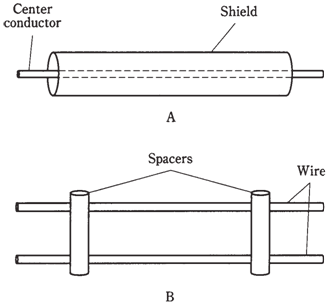Characteristic impedance:
There is a property of electronic components sometimes called as impedance, that really is not impedance at all. The is characteristic impedance or surge

Figure-- Vectors representing an absolute value impedance of 8Ω.
impedance. It is represented as Zo, and is a specification of the transmission lines. It can be expressed as a positive real number always.
Transmission lines
Any time which it is necessary to get the energy or signals from one place to the other place, a transmission line is needed. These almost take either of 2 forms, coaxial or two wire. These are shown qualitatively in the Figure given below.
Examples of transmission lines include ribbon which goes from a television antenna to the receiver, cable running from a hi-fi amplifier to speakers, and the set of wires which carries electricity over countryside.
Factors affecting Zo
The Zoh of the parallel wire transmission line depends on diameter of wires, on the spacing between wires, and on the nature of insulating material separating the wires.

Figure-- At point A, coaxial transmission line. At point B, parallel-wire transmission line.
Generally Zo increases as wire diameter gets smaller, and decreases as wire diameter gets larger, all the other things being same.
In the coaxial line, thicker the center conductor, lower will be Zo if the shield remains the same size. If the center conductor stays same size and shield tubing increases in diameter, Zo will certainly increase. In general, Zo increases as spacing between wires, or between center conductor and the shield or braid, becomes greater, and decreases as spacing is made less. Solid dielectrics like polyethylene reduce the Zo of a transmission line, as compared with air or a vacuum between conductors.
ZO in practice
The characteristic impedance of a line can be determined according to nature of the load with which the line works at the highest efficiency.
Assume that you have an 8-Ω hi-fi speaker, and you want to get the audio energy to which speaker having the greatest possible efficiency, such that the least possible power is dissipated in line. You would use large diameter wires, but for the true optimization, you would want spacing between wires to be perfectly right. Adjusting this spacing for the optimum power transfer would result in the line Zo of 8 Ω. Then, greatest possible efficiency having the speaker of impedance 8+ j0.
Ιf you cannot get the wires to have the right size and spacing for the good match to Z =8 Ω, you may need to use the impedance transformer. This makes the speaker's impedance look like something else, such as 50 Ω or 600 Ω. Suppose that you have a 300-Ω television antenna, and you want best possible reception. You purchase 300-Ω ribbon line, having a value of Zo which has been optimized by manufacturer for use with the antennas whose impedances are around 300+ j0.
For the system having an impedance of RΩ, the best line Zo is R Ω. If R is quite different from Zo, an needless of power will be wasted in heating up the transmission line. This might not be an important amount of power, but it at times is.